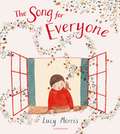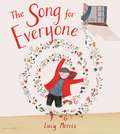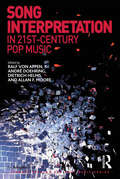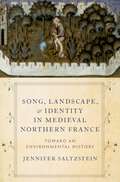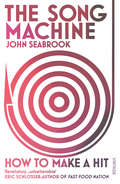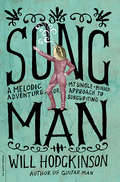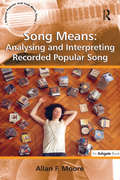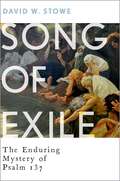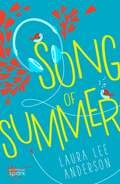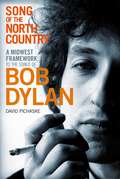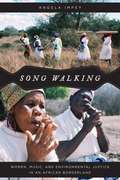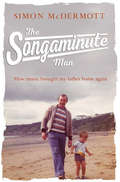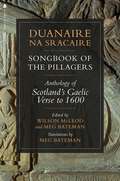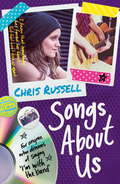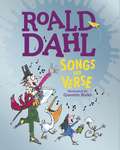- Table View
- List View
The Song for Everyone
by Lucy MorrisA stunningly illustrated picture book debut about the power of music to transform hearts and minds. From a tiny window, way up high, came a delicate tune. A melody, a song, a sound so sweet … Day after day, the song drifts on to the breeze and through the town. It makes the old feel young and comforts the lonely. It fills the whole town with joy and kindness. No one knows who sings the song, but they know it is good. Until one day, the music stops. Can the town work together to save the song for everyone?In a gorgeous, lyrical story, debut picture-book creator Lucy Morris celebrates the joy of music, the importance of community, and the beauty of simple kindnesses. Sometimes it's the smallest things that draw us together.Timeless and comforting, this beautiful picture book is one to read again and again.
The Song for Everyone
by Lucy MorrisThis stunningly illustrated picture book debut about the power of music to transform hearts and minds will be an instant classic.A cat, a boy, an elderly woman, and a line of students may appear to have little in common, but when they pass under the same window, each are swept up and transformed in different ways by the magical music that streams toward them and buoys their weary spirits. But one day, the music stops, and the town must work together to save the music that they grew to love. The Song for Everyone is a stunning allegory for the emotional complexities we carry within us, the universally soothing effects of music, and the importance of community. Timeless and comforting, this picture book is one to read again and again.
Song Interpretation in 21st-Century Pop Music (Ashgate Popular and Folk Music Series)
by Ralf von Appen André Doehring Allan F. MooreExisting books on the analysis of popular music focus on theory and methodology, and normally discuss parts of songs briefly as examples. The impression often given is that songs are being chosen simply to illuminate and exemplify a theoretical position. In this book the obverse is true: songs take centre stage and are given priority. The authors analyse and interpret them intensively from a variety of theoretical positions that illuminate the song. Thus, methods and theories have to prove their use value in the face of a heterogeneous, contemporary repertoire. The book brings together researchers from very different cultural backgrounds and encourages them to compare their different hearings and to discuss the ways in which they make sense of specific songs. All songs analysed are from the new millennium, most of them not older than three years. Because the most widely popular styles are too often ignored by academics, this book aims to shed light on how million sellers work musically. Therefore, it encompasses a broad palette, highlighting mainstream pop (Lady Gaga, Ke$ha, Lucenzo, Amy McDonald), but also accounting for critically acclaimed ’indie’ styles (Fleet Foxes, Death Cab for Cutie, PJ Harvey), R&B (Destiny’s Child, Janelle Monae), popular hard rock (Kings of Leon, Rammstein), and current electronic music (Andrés, Björk). By concentrating on 13 well-known songs, this book offers some model analyses that can very easily be studied at home or used in seminars and classrooms for students of popular music at all academic levels.
Song Interpretation in 21st-Century Pop Music (Ashgate Popular and Folk Music Series)
by Ralf von Appen André Doehring Allan F. MooreExisting books on the analysis of popular music focus on theory and methodology, and normally discuss parts of songs briefly as examples. The impression often given is that songs are being chosen simply to illuminate and exemplify a theoretical position. In this book the obverse is true: songs take centre stage and are given priority. The authors analyse and interpret them intensively from a variety of theoretical positions that illuminate the song. Thus, methods and theories have to prove their use value in the face of a heterogeneous, contemporary repertoire. The book brings together researchers from very different cultural backgrounds and encourages them to compare their different hearings and to discuss the ways in which they make sense of specific songs. All songs analysed are from the new millennium, most of them not older than three years. Because the most widely popular styles are too often ignored by academics, this book aims to shed light on how million sellers work musically. Therefore, it encompasses a broad palette, highlighting mainstream pop (Lady Gaga, Ke$ha, Lucenzo, Amy McDonald), but also accounting for critically acclaimed ’indie’ styles (Fleet Foxes, Death Cab for Cutie, PJ Harvey), R&B (Destiny’s Child, Janelle Monae), popular hard rock (Kings of Leon, Rammstein), and current electronic music (Andrés, Björk). By concentrating on 13 well-known songs, this book offers some model analyses that can very easily be studied at home or used in seminars and classrooms for students of popular music at all academic levels.
Song, Landscape, and Identity in Medieval Northern France: Toward an Environmental History
by Jennifer SaltzsteinSong, Landscape, and Identity in Medieval Northern France offers a new perspective on how medieval song expressed relationships between people and their environments. Informed by environmental history and harnessing musicological and ecocritical approaches, author Jennifer Saltzstein draws connections between the nature imagery that pervades songs written by the trouvères of northern France to the physical terrain and climate of the lands on which their authors lived. In doing so, she analyzes the different ways in which composers' lived environments related to their songs and categorizes their use of nature imagery as realistic, aspirational, or nostalgic. Demonstrating a cycle of mutual impact between nature and culture, Saltzstein argues that trouvère songs influenced the ways particular groups of medieval people defined their identities, encouraging them to view themselves as belonging to specific landscapes. The book offers close readings of love songs, pastourelles, motets, and rondets from the likes of Gace Brulé, Adam de la Halle, Guillaume de Machaut, and many others. Saltzstein shows how their music-text relationships illuminate the ways in which song helped to foster identities tied to specific landscapes among the knightly classes, the clergy, aristocratic women, and peasants. By connecting social types to topographies, trouvère songs and the manuscripts in which they were preserved presented models of identity for later generations of songwriters, performers, listeners, patrons, and readers to emulate, thereby projecting into the future specific ways of being on the land. Written in the long thirteenth century during the last major era of climate change, trouvère songs, as Saltzstein demonstrates, shape our understanding of how identity formation has rested on relationships between nature, culture, and change.
Song, Landscape, and Identity in Medieval Northern France: Toward an Environmental History
by Jennifer SaltzsteinSong, Landscape, and Identity in Medieval Northern France offers a new perspective on how medieval song expressed relationships between people and their environments. Informed by environmental history and harnessing musicological and ecocritical approaches, author Jennifer Saltzstein draws connections between the nature imagery that pervades songs written by the trouvères of northern France to the physical terrain and climate of the lands on which their authors lived. In doing so, she analyzes the different ways in which composers' lived environments related to their songs and categorizes their use of nature imagery as realistic, aspirational, or nostalgic. Demonstrating a cycle of mutual impact between nature and culture, Saltzstein argues that trouvère songs influenced the ways particular groups of medieval people defined their identities, encouraging them to view themselves as belonging to specific landscapes. The book offers close readings of love songs, pastourelles, motets, and rondets from the likes of Gace Brulé, Adam de la Halle, Guillaume de Machaut, and many others. Saltzstein shows how their music-text relationships illuminate the ways in which song helped to foster identities tied to specific landscapes among the knightly classes, the clergy, aristocratic women, and peasants. By connecting social types to topographies, trouvère songs and the manuscripts in which they were preserved presented models of identity for later generations of songwriters, performers, listeners, patrons, and readers to emulate, thereby projecting into the future specific ways of being on the land. Written in the long thirteenth century during the last major era of climate change, trouvère songs, as Saltzstein demonstrates, shape our understanding of how identity formation has rested on relationships between nature, culture, and change.
The Song Machine: How to Make a Hit
by John SeabrookHow do you make a song a global smash hit that is guaranteed to make $millions? Who are the hit-manufacturers that can create a tune that is so catchy, so wildly addictive, that it sticks in the minds of millions of listeners? And who are the powerful few that have the capacity to transform, say, a young Barbadian woman called Robyn Rihanna Fenty into the global megastar that is Rihanna? In The Song Machine, John Seabrook dissects the workings of this machine, travelling the world to reveal its hidden formulas, and interview its geniuses – ‘the hitmakers’ – at the centre of it all. Hilarious and jaw-droppingly shocking, this book will change how you think and feel about music, as well as how you listen to it.
Song Man: A Melodic Adventure, or, My Single-Minded Approach to Songwriting
by Will HodgkinsonSong man is the endearing sequel to Will Hodgkinson's Guitar Man, wherein our hero, having learned to play guitar (badly) in six months, endeavors to unlock the process of songwriting and ultimately record a single. Featuring pithy, humorous, and illuminating one-on-one songwriting lessons with Keith Richards of the Rolling Stones, Ray Davies of the Kinks, Andy Partridge of XTC, Arthur Lee of Love, Chan Marshall of Cat Power, Bob Stanley of Saint Etienne, Gruff Rhys of Super Furry Animals, and a host of others who run the gamut from unknown muses to cult icons to superstars-including Hodgkinson's lovable crew of ne'er-do-wells first introduced in Guitar Man-Song Man is at once an investigation into the most ephemeral of arts and a highly readable journey of discovery.
Song Means: Analysing and Interpreting Recorded Popular Song (Ashgate Popular and Folk Music Series)
by Allan F. MooreThe musicological study of popular music has developed, particularly over the past twenty years, into an established aspect of the discipline. The academic community is now well placed to discuss exactly what is going on in any example of popular music and the theoretical foundation for such analytical work has also been laid, although there is as yet no general agreement over all the details of popular music theory. However, this focus on the what of musical detail has left largely untouched the larger question - so what? What are the consequences of such theorization and analysis? Scholars from outside musicology have often argued that too close a focus on musicological detail has left untouched what they consider to be more urgent questions related to reception and meaning. Scholars from inside musicology have responded by importing into musicological discussion various aspects of cultural theory. It is in that tradition that this book lies, although its focus is slightly different. What is missing from the field, at present, is a coherent development of the what into the so what of music theory and analysis into questions of interpretation and hermeneutics. It is that fundamental gap that this book seeks to fill. Allan F. Moore presents a study of recorded popular song, from the recordings of the 1920s through to the present day. Analysis and interpretation are treated as separable but interdependent approaches to song. Analytical theory is revisited, covering conventional domains such as harmony, melody and rhythm, but does not privilege these at the expense of domains such as texture, the soundbox, vocal tone, and lyrics. These latter areas are highly significant in the experience of many listeners, but are frequently ignored or poorly treated in analytical work. Moore continues by developing a range of hermeneutic strategies largely drawn from outside the field (strategies originating, in the most part, within psychology and philosophy) but still deeply r
Song Means: Analysing and Interpreting Recorded Popular Song (Ashgate Popular and Folk Music Series)
by Allan F. MooreThe musicological study of popular music has developed, particularly over the past twenty years, into an established aspect of the discipline. The academic community is now well placed to discuss exactly what is going on in any example of popular music and the theoretical foundation for such analytical work has also been laid, although there is as yet no general agreement over all the details of popular music theory. However, this focus on the what of musical detail has left largely untouched the larger question - so what? What are the consequences of such theorization and analysis? Scholars from outside musicology have often argued that too close a focus on musicological detail has left untouched what they consider to be more urgent questions related to reception and meaning. Scholars from inside musicology have responded by importing into musicological discussion various aspects of cultural theory. It is in that tradition that this book lies, although its focus is slightly different. What is missing from the field, at present, is a coherent development of the what into the so what of music theory and analysis into questions of interpretation and hermeneutics. It is that fundamental gap that this book seeks to fill. Allan F. Moore presents a study of recorded popular song, from the recordings of the 1920s through to the present day. Analysis and interpretation are treated as separable but interdependent approaches to song. Analytical theory is revisited, covering conventional domains such as harmony, melody and rhythm, but does not privilege these at the expense of domains such as texture, the soundbox, vocal tone, and lyrics. These latter areas are highly significant in the experience of many listeners, but are frequently ignored or poorly treated in analytical work. Moore continues by developing a range of hermeneutic strategies largely drawn from outside the field (strategies originating, in the most part, within psychology and philosophy) but still deeply r
Song of Exile: The Enduring Mystery of Psalm 137
by David W. StoweOft-referenced and frequently set to music, Psalm 137 - which begins "By the rivers of Babylon, there we sat down, yea, we wept, when we remembered Zion" - has become something of a cultural touchstone for music and Christianity across the Atlantic world. It has been a top single more than once in the 20th century, from Don McLean's haunting Anglo-American folk cover to Boney M's West Indian disco mix. In Song of Exile, David Stowe uses a wide-ranging, interdisciplinary approach that combines personal interviews, historical overview, and textual analysis to demonstrate the psalm's enduring place in popular culture. The line that begins Psalm 137 - one of the most lyrical of the Hebrew Bible - has been used since its genesis to evoke the grief and protest of exiled, displaced, or marginalized communities. Despite the psalm's popularity, little has been written about its reception during the more than 2,500 years since the Babylonian exile. Stowe locates its use in the American Revolution and the Civil Rights movement, and internationally by anti-colonial Jamaican Rastafari and immigrants from Ireland, Korea, and Cuba. He studies musical references ranging from the Melodians' Rivers of Babylon to the score in Kazakh film Tulpan. Stowe concludes by exploring the presence and absence in modern culture of the often-ignored final words: "Happy shall he be, that taketh and dasheth thy little ones against the stones." Usually excised from liturgy and forgotten by scholars, Stowe finds these words echoed in modern occurrences of genocide and ethnic cleansing, and more generally in the culture of vengeance that has existed in North America from the earliest conflicts with Native Americans. Based on numerous interviews with musicians, theologians, and writers, Stowe reconstructs the rich and varied reception history of this widely used, yet mysterious, text.
Song of Exile: The Enduring Mystery of Psalm 137
by David W. StoweOft-referenced and frequently set to music, Psalm 137 - which begins "By the rivers of Babylon, there we sat down, yea, we wept, when we remembered Zion" - has become something of a cultural touchstone for music and Christianity across the Atlantic world. It has been a top single more than once in the 20th century, from Don McLean's haunting Anglo-American folk cover to Boney M's West Indian disco mix. In Song of Exile, David Stowe uses a wide-ranging, interdisciplinary approach that combines personal interviews, historical overview, and textual analysis to demonstrate the psalm's enduring place in popular culture. The line that begins Psalm 137 - one of the most lyrical of the Hebrew Bible - has been used since its genesis to evoke the grief and protest of exiled, displaced, or marginalized communities. Despite the psalm's popularity, little has been written about its reception during the more than 2,500 years since the Babylonian exile. Stowe locates its use in the American Revolution and the Civil Rights movement, and internationally by anti-colonial Jamaican Rastafari and immigrants from Ireland, Korea, and Cuba. He studies musical references ranging from the Melodians' Rivers of Babylon to the score in Kazakh film Tulpan. Stowe concludes by exploring the presence and absence in modern culture of the often-ignored final words: "Happy shall he be, that taketh and dasheth thy little ones against the stones." Usually excised from liturgy and forgotten by scholars, Stowe finds these words echoed in modern occurrences of genocide and ethnic cleansing, and more generally in the culture of vengeance that has existed in North America from the earliest conflicts with Native Americans. Based on numerous interviews with musicians, theologians, and writers, Stowe reconstructs the rich and varied reception history of this widely used, yet mysterious, text.
Song of Summer
by Laura Lee AndersonThe thirteen qualities of Robin's Perfect Man range from the mildly important "Handsome†? to the all-important "Great taste in music.†? After all, Westfield's best high school folk musician can't go out with some schmuck who only listens to top 40 crap. So when hot Carter Paulson walks in the door of Robin's diner, it looks like the list may have come to life after all...until she realizes he's profoundly deaf. Carter isn't looking for a girlfriend. Especially not a hearing one. Not that he has anything against hearing girls, they just don't speak the same language. But when the cute waitress at Grape Country Dairy makes an effort to talk with him, he takes her out on his yellow Ducati motorcycle.Music, language, and culture all take a backseat as love drives the bike. But how long can this summer really last?
Song of the North Country: A Midwest Framework to the Songs of Bob Dylan
by David PichaskeA remarkably fresh piece of Dylan scholarship, focusing on the profound impact that his Midwestern roots have had on his songs, politics, and prophetic character.
Song Walking: Women, Music, and Environmental Justice in an African Borderland (Chicago Studies in Ethnomusicology)
by Angela ImpeySong Walking explores the politics of land, its position in memories, and its foundation in changing land-use practices in western Maputaland, a borderland region situated at the juncture of South Africa, Mozambique, and Swaziland. Angela Impey investigates contrasting accounts of this little-known geopolitical triangle, offsetting textual histories with the memories of a group of elderly women whose songs and everyday practices narrativize a century of borderland dynamics. Drawing evidence from women’s walking songs (amaculo manihamba)—once performed while traversing vast distances to the accompaniment of the European mouth-harp (isitweletwele)—she uncovers the manifold impacts of internationally-driven transboundary environmental conservation on land, livelihoods, and local senses of place. This book links ethnomusicological research to larger themes of international development, environmental conservation, gender, and local economic access to resources. By demonstrating that development processes are essentially cultural processes and revealing how music fits within this frame, Song Walking testifies to the affective, spatial, and economic dimensions of place, while contributing to a more inclusive and culturally apposite alignment between land and environmental policies and local needs and practices.
Song Walking: Women, Music, and Environmental Justice in an African Borderland (Chicago Studies in Ethnomusicology)
by Angela ImpeySong Walking explores the politics of land, its position in memories, and its foundation in changing land-use practices in western Maputaland, a borderland region situated at the juncture of South Africa, Mozambique, and Swaziland. Angela Impey investigates contrasting accounts of this little-known geopolitical triangle, offsetting textual histories with the memories of a group of elderly women whose songs and everyday practices narrativize a century of borderland dynamics. Drawing evidence from women’s walking songs (amaculo manihamba)—once performed while traversing vast distances to the accompaniment of the European mouth-harp (isitweletwele)—she uncovers the manifold impacts of internationally-driven transboundary environmental conservation on land, livelihoods, and local senses of place. This book links ethnomusicological research to larger themes of international development, environmental conservation, gender, and local economic access to resources. By demonstrating that development processes are essentially cultural processes and revealing how music fits within this frame, Song Walking testifies to the affective, spatial, and economic dimensions of place, while contributing to a more inclusive and culturally apposite alignment between land and environmental policies and local needs and practices.
Song Walking: Women, Music, and Environmental Justice in an African Borderland (Chicago Studies in Ethnomusicology)
by Angela ImpeySong Walking explores the politics of land, its position in memories, and its foundation in changing land-use practices in western Maputaland, a borderland region situated at the juncture of South Africa, Mozambique, and Swaziland. Angela Impey investigates contrasting accounts of this little-known geopolitical triangle, offsetting textual histories with the memories of a group of elderly women whose songs and everyday practices narrativize a century of borderland dynamics. Drawing evidence from women’s walking songs (amaculo manihamba)—once performed while traversing vast distances to the accompaniment of the European mouth-harp (isitweletwele)—she uncovers the manifold impacts of internationally-driven transboundary environmental conservation on land, livelihoods, and local senses of place. This book links ethnomusicological research to larger themes of international development, environmental conservation, gender, and local economic access to resources. By demonstrating that development processes are essentially cultural processes and revealing how music fits within this frame, Song Walking testifies to the affective, spatial, and economic dimensions of place, while contributing to a more inclusive and culturally apposite alignment between land and environmental policies and local needs and practices.
Song Walking: Women, Music, and Environmental Justice in an African Borderland (Chicago Studies in Ethnomusicology)
by Angela ImpeySong Walking explores the politics of land, its position in memories, and its foundation in changing land-use practices in western Maputaland, a borderland region situated at the juncture of South Africa, Mozambique, and Swaziland. Angela Impey investigates contrasting accounts of this little-known geopolitical triangle, offsetting textual histories with the memories of a group of elderly women whose songs and everyday practices narrativize a century of borderland dynamics. Drawing evidence from women’s walking songs (amaculo manihamba)—once performed while traversing vast distances to the accompaniment of the European mouth-harp (isitweletwele)—she uncovers the manifold impacts of internationally-driven transboundary environmental conservation on land, livelihoods, and local senses of place. This book links ethnomusicological research to larger themes of international development, environmental conservation, gender, and local economic access to resources. By demonstrating that development processes are essentially cultural processes and revealing how music fits within this frame, Song Walking testifies to the affective, spatial, and economic dimensions of place, while contributing to a more inclusive and culturally apposite alignment between land and environmental policies and local needs and practices.
Song Walking: Women, Music, and Environmental Justice in an African Borderland (Chicago Studies in Ethnomusicology)
by Angela ImpeySong Walking explores the politics of land, its position in memories, and its foundation in changing land-use practices in western Maputaland, a borderland region situated at the juncture of South Africa, Mozambique, and Swaziland. Angela Impey investigates contrasting accounts of this little-known geopolitical triangle, offsetting textual histories with the memories of a group of elderly women whose songs and everyday practices narrativize a century of borderland dynamics. Drawing evidence from women’s walking songs (amaculo manihamba)—once performed while traversing vast distances to the accompaniment of the European mouth-harp (isitweletwele)—she uncovers the manifold impacts of internationally-driven transboundary environmental conservation on land, livelihoods, and local senses of place. This book links ethnomusicological research to larger themes of international development, environmental conservation, gender, and local economic access to resources. By demonstrating that development processes are essentially cultural processes and revealing how music fits within this frame, Song Walking testifies to the affective, spatial, and economic dimensions of place, while contributing to a more inclusive and culturally apposite alignment between land and environmental policies and local needs and practices.
Song Walking: Women, Music, and Environmental Justice in an African Borderland (Chicago Studies in Ethnomusicology)
by Angela ImpeySong Walking explores the politics of land, its position in memories, and its foundation in changing land-use practices in western Maputaland, a borderland region situated at the juncture of South Africa, Mozambique, and Swaziland. Angela Impey investigates contrasting accounts of this little-known geopolitical triangle, offsetting textual histories with the memories of a group of elderly women whose songs and everyday practices narrativize a century of borderland dynamics. Drawing evidence from women’s walking songs (amaculo manihamba)—once performed while traversing vast distances to the accompaniment of the European mouth-harp (isitweletwele)—she uncovers the manifold impacts of internationally-driven transboundary environmental conservation on land, livelihoods, and local senses of place. This book links ethnomusicological research to larger themes of international development, environmental conservation, gender, and local economic access to resources. By demonstrating that development processes are essentially cultural processes and revealing how music fits within this frame, Song Walking testifies to the affective, spatial, and economic dimensions of place, while contributing to a more inclusive and culturally apposite alignment between land and environmental policies and local needs and practices.
The Songaminute Man: How Music Brought My Father Home Again
by Simon McDermottThe nostalgic memoir of a young man, eldest of fourteen, growing up in 40s Wednesbury. The heartbreaking true account of his son struggling to come to terms with his father’s dementia. A tribute to the unbreakable bond between father and son.
Songbook of the Pillagers/ Duanaire na Sracaire: Anthology of Scotland’s Gaelic Verse to 1600
by Wilson McLeod and Meg BatemanDuanaire na Sracaire is the first anthology to bring together Scotland's Gaelic poetry from the millennium c.600–1600 ad, when Scotland shared its rich culture with Ireland. It includes a huge range of diverse poetry: prayers and hymns of Iona, Fenian lays, praise poems and satires, courtly songs and lewd rants, songs of battle and death, incantations and love poems. All poems appear with facing-page translations which capture the spirit and beauty of the originals and are accompanied by detailed notes. A comprehensive introduction sets the context and analyses the role and functions of poetry in Gaelic society. This collection will appeal to poetry lovers, Gaelic speakers and those keen to explore a vital part of Scotland's literary heritage.
Songs About a Girl: Book 2 from a Zoella Book Club 2017 friend (Songs About a Girl)
by Chris RussellHeartbreak, romance, fame and pop music - for anyone who's ever dreamed of saying 'I'm with the band'. From a Zoella Book Club friend.Two months on from the explosive finale to book one, Charlie's life is almost back to normal again: rebuilding her relationship with her father, hanging out with best mate Melissa, and worrying about GCSEs. All the while, Gabe's revelations about her mother are never far from her mind. And neither is Gabe.It's not long before Charlie is pulled back into the world of Fire&Lights - but the band seem different this time. But then again, so is she...Meanwhile, tensions between Gabe and Olly continue to run high, leading to more turmoil between the band members and press than ever before. But when Gabriel and Charlie stumble upon yet another startling truth that links them together - everything they have stands to implode in front of them.'A thoroughly absorbing tale of family relationships, friendship and betrayal. Fans of Non Pratt will love it' School Librarian
Songs About a Girl: Book 1 from a Zoella Book Club 2017 friend (Songs About a Girl)
by Chris RussellHeartbreak, romance, fame and pop music - for anyone who's ever dreamed of saying 'I'm with the band'. From a Zoella Book Club friend.Charlie Bloom never wanted to be 'with the band'. She's happiest out of the spotlight, behind her camera, unseen and unnoticed. But when she's asked to take backstage photos for hot new boy band, Fire&Lights, she can't pass up the chance. Catapulted into a world of paparazzi and backstage bickering, Charlie soon becomes caught between gorgeous but damaged frontman Gabriel West and his boy-next-door bandmate, Olly Samson. Then, as the boys' rivalry threatens to tear the band apart, Charlie stumbles upon a mindblowing secret, hidden in the lyrics of their songs ...'A thoroughly absorbing tale of family relationships, friendship and betrayal. Fans of Non Pratt will love it' - School Librarian'The ending was a fantastic cliff-hanger and definitely has me eager for more - WHEN WILL THE SEQUEL BE IN MY LIFE?' - Queen of Teen Fiction'Songs About a Girl is more than music, its about growing up, dealing with issues that others face every day, its about becoming a stronger person for yourself and never giving up on your dream. It's a book that you can fall into and never want it to end, and I really need the next installment now please' - Much Loved Books
Songs and Verse
by Roald DahlThink of your favourite Roald Dahl moment and surely a song or verse cannot be far away...SONGS AND VERSE has seven sections bursting with rhymes about monsters, magical creatures, gruesome children, ghastly adults as well as a few unusual surprises. From the strange and scrumptious dishes enjoyed by James's Centipede to George and his marvellous medicine, and from greedy Augustus Gloop to the Giraffe and the Pelly and Me there are many classics here together with some previously unpublished treats. With a foreword and opening illustrations by Quentin Blake, and illustrations throughout from other award-winning artists such as Babette Cole, Lauren Child, Chris Riddell, Alel Scheffler and Tony Ross, you will find a touch of magic on every page.
